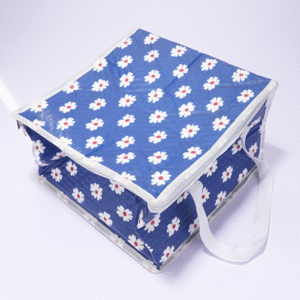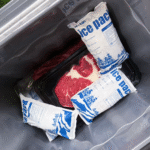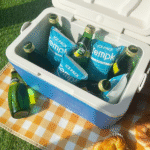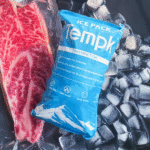What Is the Cold Chain? A Clear Definition & 2025 مرشد
Updated November 10 2025
مقدمة: When you hear the term cold chain definition, you might picture refrigerated trucks or warehouses. في الواقع, the cold chain is a coordinated system that keeps perishable goods within strict temperature ranges from production to consumption. This article gives you a clear definition of the cold chain, explains its components, shows why it matters and explores the latest regulations and trends. A high quality cold chain can be the difference between safe vaccines reaching a child and wasted doses. The global cold chain logistics market accounted for دولار أمريكي 436.30 مليار في 2025 ومن المتوقع أن يصل دولار أمريكي 1,359.78 مليار من قبل 2034, highlighting the growing importance of temperature controlled supply chains.
What does “cold chain” actually mean? A concise definition with practical examples using long tail keywords like “what is cold chain management” و “temperature controlled supply chain definition”.
Why is the cold chain important for health and food safety? Insights into how temperature fluctuations affect vaccines and food, using long tail keywords like “importance of cold chain logistics” و “cold chain management definition”.
What are the key components of an effective cold chain? An overview of storage, مواصلات, monitoring and information systems, plus a table of typical temperature ranges for different products.
How do FSMA Rule 204 and other regulations affect the cold chain? A clear explanation of the 2026 traceability rule and its 24 hour record availability requirement.
What trends and innovations are shaping cold chain logistics in 2025? Highlights of AI route optimization, الصيانة التنبؤية, مستشعرات إنترنت الأشياء, blockchain and sustainable packaging.
الأسئلة المتداولة about cold chain management, temperature monitoring and compliance.
What Is the Cold Chain and Why Should You Care?
إجابة مباشرة: ال سلسلة البرد is a temperature controlled supply chain that uses refrigerated production, storage and distribution facilities to keep goods within specified temperature ranges. It ensures that vaccines, fresh foods and other perishable items remain safe and effective during transport. Food and health products rely on precise temperature control; even a brief exposure outside the recommended range can cause vaccines to lose potency or food to spoil. بعبارات بسيطة, the cold chain keeps your ice cream frozen and your medication potent throughout their journey.
التفسير الموسع: Think of the cold chain as a relay race where each stage must hand off the product at the right temperature. It starts at production (a pharmaceutical factory or dairy farm), continues through refrigerated warehouses and transport vehicles, and ends with delivery to retailers or clinics. ال التحالف العالمي لسلسلة التبريد defines the cold chain as the management of temperature for perishable products to maintain quality and safety from origin to final consumer. This management includes cooling, التغليف, real time monitoring and timely distribution. على سبيل المثال, UNICEF’s vaccine distribution network coordinates a series of temperature controlled events—from the manufacturer to local health centers—to ensure children receive effective immunizations. You may not see these processes, but they protect you when you enjoy fresh sushi or receive a life saving drug.
Cold Chain vs. إدارة سلسلة التبريد
تفاصيل: بينما “سلسلة البرد” refers to the physical system, cold chain management encompasses planning and controlling each link. According to ScanTexas, cold chain management is when you control the temperature of a place where perishable goods are stored to maintain quality from origin to destination. This includes designing packaging, training staff, using refrigerated vehicles and ensuring compliance with regulations. Each product type has a specific temperature range (انظر الجدول أدناه). The management component involves careful monitoring, documentation and corrective actions if conditions deviate.
| نطاق درجة الحرارة النموذجي | Degrees (° f) | Degrees (درجة مئوية) | ماذا يعني لك |
| Ambient fresh produce | 57–75 °F | ~14–24 °C | Suitable for hardy fruits and vegetables; maintaining quality at room temperature. |
| Chilled produce & ألبان | 45–57 °F | ~7–14 °C | Keeps fruits, vegetables and dairy fresh without freezing. |
| الأدوية | 36–46 °F | ~2–8 °C | Prevents vaccines and biologics from losing efficacy. |
| اللحوم المجمدة & المأكولات البحرية | –0.5–32 °F | ~–18–0 °C | Maintains texture and safety of meats. |
| Deep frozen goods | –22– –0.5 °F | ~–30– –18 °C | Required for gene therapies and deep frozen meats; prevents microbial growth. |
Practical Tips for Understanding the Definition
Imagine a relay race: Every hand off matters. If one runner drops the baton (allowing a temperature excursion), the product can be compromised. This mental model helps you grasp why the cold chain is more than just refrigeration.
Check product labels: Most temperature sensitive products list storage conditions. Recognizing these ranges helps you see how the cold chain protects quality.
Think of your groceries: When you buy ice cream, you rely on a sequence of freezers, trucks and stores. This everyday example shows the hidden complexity behind a simple treat.
حالة العالم الحقيقي: GEP’s glossary notes that vaccines require constant temperatures and that even short deviations can make them unfit for use. خلال جائحة كوفيد 19, this understanding prompted massive investments in cold chain infrastructure and monitoring, illustrating how definitions translate into public health outcomes.
Why Is the Cold Chain Critical for Food Safety and Health?
إجابة مباشرة: The cold chain prevents spoilage and protects public health. If products are exposed to temperatures that are too high or too low, they may experience textural degradation, discoloration or microbial growth. للقاحات, potency can be lost and cannot be restored. Proper cold chain management keeps food safe, reduces waste and ensures life saving medicines maintain their efficacy.
التفسير الموسع: Food and pharmaceutical products are particularly susceptible to temperature changes. When stored at incorrect temperatures, microbes multiply quickly and cause foodborne illnesses. In the case of vaccines, extreme temperatures can degrade biological molecules. The Global Cold Chain Alliance emphasizes that failing to keep products at the correct temperatures results in poor quality and can lead to public health risks. Effective cold chains also support local economies by reducing waste and enhancing consumer trust. According to Precedence Research, the cold chain logistics market is expected to expand at a CAGR of 13.46% من 2025 ل 2034, reflecting escalating demand for safe and high quality products worldwide.
Food Safety Challenges and Solutions
تفاصيل: Cold chain failures often stem from temperature fluctuations during storage, transport or hand off. Common issues include power outages, inadequate insulation, staff errors and equipment malfunctions. ScanTexas notes that well trained personnel and efficient procedures are essential for avoiding issues. Investing in reliable transport (refrigerated vehicles, thermal blankets and vacuum panels) and using real time temperature monitoring can prevent product spoilage. للمستهلكين, checking “use by” dates and ensuring groceries are refrigerated promptly reduces risks.
| عامل الخطر | وصف | How It Affects You |
| Temperature fluctuations | Power outages or inadequate equipment lead to temperature spikes. | Causes spoilage and potential health hazards. |
| Wastage of packaging & مواد | Scarce and expensive materials are wasted due to poor planning. | Raises costs and reduces sustainability. |
| Inadequate training | Staff lack knowledge of proper procedures. | Increases errors and delays in response. |
| عدم الامتثال التنظيمي | Missing records or improper storage conditions. | Leads to fines, recalls and reputational damage. |
Tips to Protect Yourself & Your Business
Use reliable equipment: Choose insulated containers, refrigerated trucks and warehouses with backup power.
تدريب فريقك: Regular training ensures staff understand temperature ranges and emergency responses.
Implement monitoring tools: مسجلي البيانات, IoT sensors and telematics can alert you to temperature excursions before they cause damage.
خطة للطوارئ: تطوير إجراءات التشغيل القياسية (SOPS) and maintain a list of contacts for equipment repair or product diversion.
حالة العالم الحقيقي: UNICEF delivered its first vaccine shipment by sea in July 2025, transporting over 500,000 جرعات of pneumococcal vaccine from Belgium to Côte d’Ivoire. The sea journey reduced greenhouse gas emissions by up to 90 بالمائة and freight costs by 50 بالمائة compared with air transport. This innovative approach shows how sustainable cold chain solutions can improve efficiency and environmental performance while protecting product quality.
How Does the Cold Chain Work? Components & Processes Explained
إجابة مباشرة: A cold chain consists of interconnected components: production and pre cooling, refrigerated storage, insulated transportation, monitoring and data systems, regulations and compliance, و end consumer handling. Each component must function correctly to maintain temperature control and deliver safe products. Without proper coordination, the chain breaks, resulting in spoilage or loss of efficacy.
التفسير الموسع: Let’s break down these components in a more relatable way:
إنتاج & Pre cooling: Products such as vaccines, dairy or seafood are produced and quickly cooled to their required temperature. Precedence Research notes that pre cooling facilities were valued at دولار أمريكي 204.4 مليار في 2024, indicating their critical role. Pre cooling removes field heat from produce, slows microbial growth and stabilizes products before storage.
تخزين مبرد: Temperature controlled warehouses and cold rooms store goods until transportation. According to Precedence Research, refrigerated warehouses were valued at دولار أمريكي 238.29 مليار في 2024. These facilities use insulation, airflow management and backup power to ensure constant temperatures. Insulated containers at the smaller scale (على سبيل المثال, vaccine carriers) allow health workers to deliver vaccines in remote areas.
Insulated Transportation: Cold chain logistics includes refrigerated trucks, عربات السكك الحديدية, السفن والطائرات. Perishable products move between facilities while staying within their temperature range. Precedence Research states that refrigerated transportation is expected to expand at a 13.0 معدل نمو سنوي مركب في المئة. Sea shipping has emerged as a sustainable alternative; ال 2025 UNICEF shipment by sea demonstrates significant emissions and cost reductions.
يراقب & Data Systems: أجهزة الاستشعار, سجلات البيانات, telematics and IoT solutions continuously track temperature and location. Real time monitoring allows immediate corrective action and provides traceability records. The Global Cold Chain Alliance’s definition emphasizes management of temperature, and modern systems record data automatically.
أنظمة & امتثال: Legal frameworks like the U.S. قانون تحديث سلامة الأغذية (FSMA) قاعدة 204 require additional traceability records for certain foods. The rule goes into effect on يناير 20 2026 and there is no phase in period. It mandates that traceability records must be made available to the FDA داخل 24 ساعات. Compliance reduces recall times and improves consumer confidence.
End consumer Handling: أخيراً, products reach retailers and consumers. Retailers must maintain proper storage, and consumers should refrigerate perishable goods promptly. Clear labeling and consumer education ensure the chain does not break at the last step..
Temperature Control Devices & Monitoring Technologies
تفاصيل: Several tools help maintain and monitor temperatures:
مسجلي البيانات: Small devices that record temperatures at set intervals. They provide a continuous record and alert operators to deviations.
مستشعرات إنترنت الأشياء: Internet connected sensors that transmit real time temperature and location data. These devices enable proactive interventions and predictive maintenance. Modern telematics platforms integrate with fleet management systems and support remote monitoring.
RFID & BLE tags: Radio Frequency Identification and Bluetooth Low Energy tags enable contactless temperature scanning and can be attached to pallets or individual products. They facilitate automated data collection and reduce human error.
أجهزة تعقب GPS: Provide location data for shipments, enabling route optimization and timely deliveries.
Cold storage and freezer units: Include refrigerated containers, blast freezers, cryogenic units and smart refrigerators equipped with temperature alarms.
| تكنولوجيا | وظيفة | فائدة عملية |
| مسجلي البيانات | Record temperature over time | Provide continuous records for compliance and audits |
| مستشعرات إنترنت الأشياء | Transmit real time temperature and location | Enable immediate response to excursions |
| RFID/BLE tags | Automate scanning without direct line of sight | Reduce human error and speed up tracing |
| أجهزة تعقب GPS | Track shipment location | Aid in route optimization and estimated delivery times |
| Smart storage units | Maintain temperatures with alarms & الأتمتة | Reduce risk of spoilage and support predictive maintenance |
Tips for Choosing Monitoring Solutions
Identify your product’s sensitivity: Highly sensitive biologics may need continuous real time monitoring, whereas less sensitive goods can use periodic logging.
Check battery life and connectivity: Choose sensors with battery life that matches your transit time. Ensure connectivity (الخلوية, satellite or BLE) covers your routes.
Integrate with existing systems: Your monitoring solution should feed data into warehouse management or ERP systems for unified reporting.
Plan for data storage: Traceability laws require record retention for at least two years. Ensure your system archives data securely and makes it accessible when needed.
حالة العالم الحقيقي: Many vaccine distributors transitioned from paper logs to IoT sensors after recognizing that manual logs are error prone. Real time data enabled them to intercept shipments experiencing temperature excursions, reducing product loss and ensuring patient safety.
أنظمة: Understanding FSMA Rule 204 & Global Standards
إجابة مباشرة: FSMA Rule 204 is a U.S. regulation that requires companies handling certain high risk foods to keep additional traceability records and provide them to the Food and Drug Administration (FDA) داخل 24 ساعات of a request. The rule applies to items on the Food Traceability List (FTL) and goes into effect يناير 20 2026. Compliance ensures rapid response to contamination events and improves supply chain transparency.
التفسير الموسع: قانون تحديث سلامة الأغذية (FSMA) shifts the focus of U.S. food safety from reaction to prevention. قسم 204, also known as the traceability rule, mandates that entities that grow, عملية, package or distribute foods on the FTL collect and maintain data elements such as harvest location, كمية, and dates. These records must be available within 24 ساعات during an FDA investigation. Unlike previous rules, there is no phase in period; compliance is mandatory from the effective date. Companies may store records off site but must be able to access them quickly. Non compliance can lead to fines, recalls or facility shutdowns. FSMA 204 complements other global regulations such as the EU’s Good Distribution Practice (الناتج المحلي الإجمالي) guidelines and WHO’s performance standards for vaccine storage equipment.
Compliance Tips for Businesses
رسم خريطة لسلسلة التوريد الخاصة بك: Identify which products fall under the Food Traceability List and document their journey from farm or manufacturer to retailer.
Adopt digital record keeping: Use cloud based platforms that automatically capture data from sensors and create traceability reports.
Train staff on data entry and retrieval: Your team should know what information must be recorded and how to access it within the 24 hour window.
Conduct mock recalls: Periodically test your ability to trace a product quickly. This practice reveals gaps in data and encourages continuous improvement.
ابق على اطلاع: Subscribe to regulatory updates and participate in industry groups. FSMA 204 may evolve, and international regulations may impose additional requirements.
حالة العالم الحقيقي: A fresh produce company implemented a digital traceability platform to comply with FSMA 204. When a contamination issue arose, they produced complete chain of custody records within hours, avoiding a costly recall and demonstrating due diligence to regulators.
Components and Best Practices for a Robust Cold Chain
إجابة مباشرة: A robust cold chain relies on careful التغليف, يراقب, النقل, التخليص الجمركي, تخزين و consumer education. Each component has its own best practices: secure and energy efficient packaging, continuous temperature monitoring, appropriate vehicles, efficient customs documentation, quality controlled storage and clear communication to end users.
التفسير الموسع: According to ScanTexas, six components underpin effective cold chain management:
التغليف: استخدام معزول, energy efficient materials to protect goods from short term temperature fluctuations. Reusable containers and phase change materials can improve sustainability.
يراقب: Regularly check temperature and environmental parameters using sensors and data loggers. Alarms and alerts should notify operators of deviations immediately.
النقل: Employ refrigerated vehicles, البطانيات الحرارية, vacuum panels and pallets to maintain temperatures. Route optimization reduces transit time and energy use.
Clearing Customs: Proper documentation prevents delays at borders. Preclearance programs and digital customs filings can streamline this stage.
Storing: Keep products in appropriate temperature facilities and perform regular quality assurance. Backup systems and energy management improve reliability.
Educating the End Customer: Communicate storage requirements to retailers and consumers. Providing simple instructions (على سبيل المثال, “keep refrigerated at 2–8 °C”) helps maintain quality after delivery.
Choosing the Right Partners and Equipment
تفاصيل: Your success in cold chain logistics often depends on the partners you choose. Evaluate transportation providers based on equipment reliability, route planning capabilities and compliance history. Inspect warehouses for certification (such as ISO 22000 or GDP), energy efficiency and contingency planning. When selecting equipment, consider temperature accuracy, energy consumption and compatibility with digital monitoring systems. على سبيل المثال, Precedence Research notes that the dry ice segment accounted for 55.16 % of the market share in 2024, indicating a preference for certain cooling technologies. لكن, sustainable alternatives like phase change materials and vacuum insulation panels are gaining popularity.
| عنصر | اعتبارات رئيسية | مصلحتك |
| التغليف | العزل, إعادة الاستخدام, الاستدامة | Reduces waste and maintains temperature |
| يراقب | Accuracy, الاتصال, integration | Enhances visibility and compliance |
| ينقل | Vehicle type, تحسين الطريق, contingency plans | Ensures timely delivery and reduces emissions |
| Customs | Documentation readiness, regulatory knowledge | Prevents delays and spoilage |
| تخزين | التحكم في درجة الحرارة, backup power, شهادة | Maintains product quality |
| تعليم | Clear instructions, consumer awareness | Extends the cold chain to the point of use |
Tips for Internal Processes
تنفيذ إجراءات التشغيل الموحدة: Standard operating procedures outline roles, responsibilities and steps for each component. They minimize human error and improve consistency.
Review data regularly: Analyze temperature logs and performance reports to identify weak points. Use dashboards to visualize trends.
Invest in staff training: Training should cover equipment use, صحة, emergency response and regulatory requirements.
Pursue certifications: Certifications like ISO 9001, HACCP and GDP demonstrate commitment to quality and can boost customer confidence.
Adopt sustainability initiatives: Use renewable energy, optimize routes and choose eco friendly packaging to reduce your carbon footprint. Many companies now adjust cold storage temperatures from −18 °C to −15 °C to save energy without compromising quality, as recommended by industry bodies.
حالة العالم الحقيقي: A seafood exporter shifted to phase change material packaging and optimized shipping routes. They cut packaging waste by 25 % and reduced transit times by 20 %, while maintaining quality and compliance.
2025 الاتجاهات والابتكارات في مجال الخدمات اللوجستية لسلسلة التبريد
نظرة عامة على الاتجاه: The cold chain is evolving rapidly thanks to emerging technologies and sustainability pressures. Innovations such as artificial intelligence (منظمة العفو الدولية) for route optimization, predictive maintenance and demand forecasting; real time IoT monitoring; blockchain for traceability; renewable energy technologies; portable cryogenic freezers; and sustainable packaging are transforming the industry. في 2025, these innovations help companies improve efficiency, reduce environmental impact and comply with tightening regulations.
Latest Innovations Snapshot
تحسين المسار المدعوم بالذكاء الاصطناعي: AI analyzes traffic, weather and delivery data to choose the fastest, most fuel efficient routes. This reduces delivery times and carbon emissions. على سبيل المثال, AI driven logistics platforms can lower travel times and fuel costs by up to 15 %.
الصيانة التنبؤية & analytics: Sensors collect data on equipment performance and use machine learning to predict failures. Fixing equipment before it breaks minimizes downtime and product loss.
IoT enabled real time monitoring: Modern sensors provide continuous data on temperature, الرطوبة والموقع. Cloud dashboards allow operators to respond immediately to deviations.
Blockchain للتتبع: Blockchain creates an immutable record of each product’s journey, improving transparency and preventing fraud or tampering. Southeast Asian logistics companies have used blockchain combined with solar powered cold storage to track vaccine shipments.
المجمدات المبردة المحمولة: New portable freezers maintain temperatures from −80 °C to −150 °C, enabling safe transport of advanced biologics and gene therapies over long distances.
التغليف المستدام: Recyclable and biodegradable materials replace polystyrene, تقليل النفايات. Phase change materials and vacuum insulation panels improve thermal performance.
Renewable energy and energy efficiency: Solar powered refrigeration units and AI controlled systems reduce reliance on fossil fuels. Sea shipping reduces emissions by up to 90 % compared to air transport.
رؤى السوق: Precedence Research highlights that the Asia Pacific region will grow at 14.3 % CAGR بين 2025 و 2034, driven by expanding e commerce and rising consumer expectations for fresh foods. Dairy and frozen desserts hold the largest revenue share of 36.10 %, and the dry ice technology segment commands 55.16 % من السوق. These statistics underscore the opportunities and challenges businesses face in scaling their cold chains.
الأسئلة المتداولة
What is the difference between a cold chain and cold chain management? A cold chain refers to the physical system of temperature controlled production, storage and transport. Cold chain management encompasses planning, monitoring and controlling every stage to maintain temperature and ensure compliance.
Why are temperature excursions dangerous? Even short exposure to incorrect temperatures can degrade vaccines and food. للقاحات, potency loss is permanent. في الطعام, spoilage results in microbial growth, discoloration and texture changes.
What is FSMA Rule 204 and when does it take effect? FSMA 204 is a U.S. traceability rule requiring additional records for certain foods. It takes effect on يناير 20 2026 and demands that records be available within 24 ساعات.
How do IoT sensors benefit cold chain management? IoT sensors transmit real time temperature and location data, enabling immediate corrective actions and predictive maintenance. They improve compliance and reduce product losses.
Which industries rely on the cold chain? الأدوية, البيولوجيا, اللقاحات, المنتجات الطازجة, اللحوم والمأكولات البحرية, ألبان, bakery products, شوكولاتة, cut flowers and even plant based proteins all require cold chain logistics. Emerging sectors such as gene therapy and cell therapy rely on ultra low temperatures.
How can small businesses comply with FSMA 204? They should map their supply chains, use affordable digital record keeping solutions, train staff and conduct periodic recall simulations. Third parties may keep records off site if they are accessible within 24 ساعات.
Are sea shipments suitable for cold chain goods? نعم, sea shipping is increasingly viable. UNICEF’s 2025 vaccine shipment reduced emissions by 90 % والتكاليف بواسطة 50 %. لكن, proper refrigeration and monitoring are vital to maintain quality during longer transit times.
ملخص & التوصيات
الوجبات الرئيسية:
ال سلسلة البرد is a temperature controlled supply chain that preserves the quality and safety of perishable products. It involves production, تخزين, ينقل, monitoring and regulation.
Precise temperature control is essential; even brief deviations can render vaccines ineffective or food unsafe.
A robust cold chain consists of well designed packaging, continuous monitoring, reliable transportation, efficient customs processes, quality storage and end consumer education.
Regulations like FSMA Rule 204 mandate detailed traceability records within 24 ساعات. Proactive compliance and digital record keeping are crucial.
Technological innovations—AI, الصيانة التنبؤية, مستشعرات إنترنت الأشياء, blockchain and sustainable packaging—are reshaping the cold chain landscape.
خطة العمل: If you operate in or depend on cold chain logistics, start by mapping your supply chain و identifying temperature sensitive products. Invest in modern monitoring technologies and align your processes with FSMA 204 وغيرها من اللوائح. يعتبر training sessions للموظفين, مبادرات الاستدامة (such as renewable energy and reusable packaging) و contingency plans for power outages or transportation disruptions. Engage with industry groups and stay current on evolving standards. A well managed cold chain not only protects products but also builds trust with your customers.
About TemPK
TemPK is a technology driven company specializing in cold chain solutions. We design and manufacture data loggers, IoT sensors and insulated packaging to help businesses maintain temperature control from production to delivery. خبرتنا تمتد إلى الأدوية, طعام, biotechnology and e commerce logistics. We emphasize accuracy, reliability and sustainability, offering products with long battery life and cloud connectivity. TemPK remains at the forefront of cold chain innovation, integrating AI and blockchain to improve traceability and efficiency.
على استعداد لتحسين سلسلة التبريد الخاصة بك? Contact our experts for a personalized consultation and discover how TemPK’s solutions can help you meet regulatory requirements, reduce waste and deliver high quality products to your customers.
























